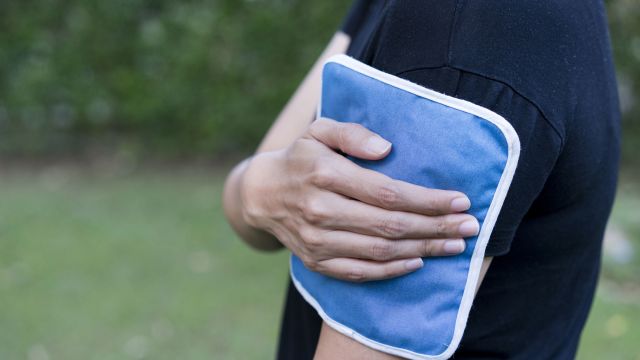Whether chronic or acute, aches, pains and injuries can put a damper on everyday activities. Along with rest and elevation, we've been told that heat and ice can speed recovery, but which is best for your particular ailment? Jonathon Faber, DO, a sports medicine specialist with Saint Joseph Mercy Health System in Livonia, Michigan, explains when you should apply ice or administer heat, and when it’s time to see your doctor.
When to opt for ice
Acute pain is sudden, brought on by a specific incident. Broken bones, sprains, strains, burns, cuts and surgery can all cause acute discomfort. As soon as the cause of pain is remedied, the uncomfortable sensation should subside. But what to do in the meantime?
As a general rule, acute injuries should be treated with an icepack, or a bag of your favorite frozen veggies. “Typically, when you have an acute injury, like an ankle sprain, it's very appropriate to apply ice for the first 48 to 72 hours,” recommends Faber.
When used promptly, ice helps reduce swelling. Swelling is caused by the rush of fluid and white blood cells to an injury, which works to promote healing and help prevent you from using the affected area. “[However,] a lot of times, swelling can be excessive enough, especially in places like the ankle and knee, that it prevents further healing,” says Faber. So, reducing swelling quickly can help speed recovery.
For some injuries, ice isn’t enough. Rest, compression and elevation are also necessary. “The acronym RICE stands for rest, ice, compression and elevation,” says Faber. “These methods reduce swelling and inflammation at the site of an injury.”
When to reach for heat
Not all types of discomfort should be treated with an ice pack. Chronic or long-lasting pain, which can persist for more than 12 weeks, is often better soothed with a heating pad. This type of discomfort may be caused by an injury or illness like arthritis or fibromyalgia, but in some cases, has no known cause. Frequently, the goal in treating chronic pain is minimizing discomfort as much as possible, to enhance your quality of life.
Here's why heat helps: while ice reduces inflammation in areas with a buildup of fluid, heat is better suited for pain not caused by swelling, like arthritic joint pain. “Heat tends to be more appropriate for joint pain in people who suffer from osteoarthritis, because it increases blood flow to affected areas,” says Faber. There are exceptions: some with arthritic joint pain may benefit from applying ice to numb the sensation of pain, as well.
Heat also helps ease discomfort linked to achy joints and stiff muscles. By improving blood flow and circulation, it relieves pain and stiffness caused by conditions like tendinosis, chronic stiffness of tendons attached to the joints.
Sometimes, pain from injuries older than six weeks can also be alleviated with heat. “After a few weeks, icing sprains and strains doesn't tend to be as beneficial,” says Faber. “At that point, it’s personal preference, and you should do what feels better.”
See your doctor
Some injuries shouldn’t be treated at home. See you doctor if:
- An injury significantly affects your range of motion, rendering you unable to complete everyday tasks like bathing, cooking or dressing.
- You injure certain parts of your body. “With any lower extremity injury, the hip, knee or ankle, that leaves you unable to bear weight, you should see your doctor,” says Faber.
- You have a minor injury, and swelling doesn’t improve after a few days of at-home treatment.
Ignoring an injury or compensating for the pain by putting more pressure on other parts of the body can lead to permanent dysfunction, making treatment difficult. In that case, your injury may be less of a job for heat or ice and more of a job for your healthcare provider.






